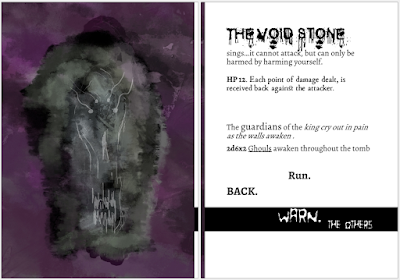 |
| Colour of the Void |
by Gizmo_the_Bugbear
Self-Published
“for use with any level adventurer because they’re all doomed anyway”
It is not fair. Mörk Borg modules are not noted for their high quality. Most barely rise above the level of crummy, and being “style over substance” is the least of their problems. I do not generally review them. Is it fair then to drag a random specimen into the limelight and savage it? No. I suppose not. But then random encounters are not fair. I bought Colour of the Void because it looked a cut above the norm – 24 pages seemed more substantial than usual, and something about the front cover looked promising. In fact, it is a lot like all the other Mörk Borg modules I have seen, with the same problems, so a general case can be made.
 |
| RUN |
Let us start with the layout. Following the convention established in the rulebook, the module is a riot of colour splashes, arbitrary font selection, and scratchy artwork (some homemade, some publicly sourced). Yes, this is part of the design style. No, it does not make for good reading or reference, it is a massive waste of printer ink, and it is a way to skimp on the actual content while inflating the page count. Colour of the Void is not as bad here as other Mörk Borg offerings, but it is pretty bad all right. Some of it is meant to convey horror with its disintegrating texts, but, let’s be honest, this has been done a myriad times, it is a waste of space, and it does not in fact make the adventure better.
 |
| Where are your loops now, MORTAL?! |
On the individual encounter level, things generally happen to the players. In a dark tunnel, “[t]he PC’s all lost one possession at random whilst stumbling through the tunnel [sic].” There are no stakes here. It is made clear that it happens whether the party has torches or not. Elsewhere, things happen based on die rolls – you can literally slip and die, as “The walls are thick with shards of sheer rock, vengeful in their nature.”, and that requires a DR12 agility check to avoiding 1d4 damage, ignoring armour. Player input is not really considered, or required in any of the encounters – they are passive observers who sometimes roll dice in combat or to see if they are harmed by a specific trap or effect.
 |
| This, my darling, is the Zybourne Clock |
What else? There is of course a boss battle set up with a cutscene, and followed by a fight sequence (the undead king has an “obliteration beam” that sounds rather neat, although it basically only does 1d6+2 points. There is a neat illustration, and another cutscene: “Upon his demise, the King’s atoms are absorbed into the ether forever. His tomb begins to collapse. The void stone is weakened and vulnerable.” Of course, the rollercoaster ride doesn’t end here - ghouls are awakened, you escape the collapsing tomb, but the town is attacked by an UNDEAD VOID PLAGUED ARMY (I can’t reproduce the blood-dripping font on this blog, sorry), led by the girl they wanted to save. Here, there is a decent doom clock mechanic, where every action to rally the townsfolk, ask for more information, and so on, advances the clock as the horde of undead draws closer, and you can conduct your second boss battle.
 |
| Artpink |
No playtesters are credited in this publication.
Rating: * /
*****

